Bangladesh : Maize prices remain high as demand for livestock feed keeps rising

In 2025, Bangladesh’s maize prices remain high due to strong feed demand from poultry, dairy, and aquaculture sectors. Wholesale and retail prices reached Tk 34.49 and Tk 38.47/kg in February. The feed industry consumes 90% of maize. Production is forecast at 58 lakh tonnes in MY26, with rising cultivation and imports from Brazil, though imports may dip as domestic output grows.
Wholesale and retail prices of maize have remained high so far in 2025, driven by sustained demand for feed from Bangladesh’s poultry, dairy, and aquaculture sectors.
In February, the wholesale price of maize stood at Tk 34.49 per kilogramme (kg), while the retail price was Tk 38.47, according to a report released last month by the United States Department of Agriculture (USDA).
Though prices tend to fall briefly during the harvest season, they typically rise again within months, reflecting strong year-round demand from the feed industry.
The country currently hosts around 150 registered feed companies producing an estimated 75 lakh tonnes of commercial feed annually. An additional 500,000 tonnes are produced by unregistered operations.
The report said Bangladesh’s feed manufacturing sector is the largest consumer of maize, accounting for 90 percent of total production, estimated at 57 lakh tonnes in the marketing year 2024-25.
The USDA report said maize makes up as much as 65 percent of poultry feed formulations. In the case of dairy feed, the grain accounts for up to 35 percent of the requirement.
Because of its strong returns and expanding demand, maize—the second-largest grain crop in the country after rice—continues to gain popularity among farmers.
In MY26, production of the grain is forecast to hit 58 lakh tonnes, the USDA forecast.
The area under cultivation is expected to increase slightly to 660,000 hectares, supported by good weather, timely fertiliser application, and irrigation.
The report added that farmers are prioritising maize cultivation due to its profitability.
Compared to rice and vegetables grown in the same season, maize has lower input costs and offers nearly three times higher returns over production expenses.
Major maize-producing districts include Lalmonirhat, Thakurgaon, Dinajpur, Nilphamari, and Rangpur, while cultivation is also spreading to char areas and coastal lands due to favourable yields.
The availability of hybrid seed varieties has pushed average yields above 10 tonnes per hectare, with some hybrids delivering even more under optimal conditions, according to the report.
Apart from increased production, Bangladesh’s maize imports have shot up to meet demand from the feed industry.
In MY25, maize imports were estimated at 16 lakh tonnes—growing nearly threefold compared to the previous year.
However, as domestic production improves and stocks build, imports are projected to fall by 12.5 percent to 14 lakh tonnes in MY26, the USDA forecast.
The report said Brazil emerged as the leading corn supplier to Bangladesh after India’s exportable surplus declined due to rising biofuel demand.
In the first 10 months of MY25, Bangladesh imported 14 lakh tonnes of maize, mainly from Brazil.
The USDA report estimates that ending stocks will reach 303,000 tonnes in MY26, down from 403,000 tonnes in the previous year.
While production prospects remain strong, challenges such as pest management persist, the report added.
To Read more about Maize News continue reading Agriinsite.com
Source : The Daily Star
















